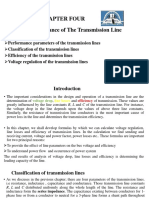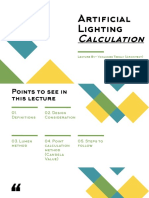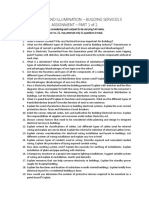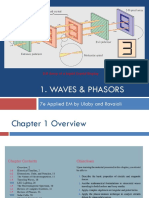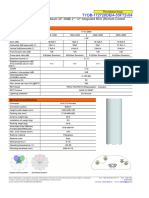0 ratings0% found this document useful (0 votes)
151 viewsILLUMINATION
ILLUMINATION
Uploaded by
Been Carlo De JasminThis document provides definitions and concepts related to light, illumination, and electrical lighting. It begins by stating that light is essential to human activities and is now primarily produced through artificial means like electrical lamps. Key terms defined include luminous intensity, luminous flux, illumination, luminance, mean candle powers, reduction factor, lamp efficiency, utilization factor, and room index. Examples are also provided to demonstrate calculations related to these lighting concepts.
Copyright:
© All Rights Reserved
Available Formats
Download as PPTX, PDF, TXT or read online from Scribd
ILLUMINATION
ILLUMINATION
Uploaded by
Been Carlo De Jasmin0 ratings0% found this document useful (0 votes)
151 views50 pagesThis document provides definitions and concepts related to light, illumination, and electrical lighting. It begins by stating that light is essential to human activities and is now primarily produced through artificial means like electrical lamps. Key terms defined include luminous intensity, luminous flux, illumination, luminance, mean candle powers, reduction factor, lamp efficiency, utilization factor, and room index. Examples are also provided to demonstrate calculations related to these lighting concepts.
Original Description:
Everything you need to know about light
Copyright
© © All Rights Reserved
Available Formats
PPTX, PDF, TXT or read online from Scribd
Share this document
Did you find this document useful?
Is this content inappropriate?
This document provides definitions and concepts related to light, illumination, and electrical lighting. It begins by stating that light is essential to human activities and is now primarily produced through artificial means like electrical lamps. Key terms defined include luminous intensity, luminous flux, illumination, luminance, mean candle powers, reduction factor, lamp efficiency, utilization factor, and room index. Examples are also provided to demonstrate calculations related to these lighting concepts.
Copyright:
© All Rights Reserved
Available Formats
Download as PPTX, PDF, TXT or read online from Scribd
Download as pptx, pdf, or txt
0 ratings0% found this document useful (0 votes)
151 views50 pagesILLUMINATION
ILLUMINATION
Uploaded by
Been Carlo De JasminThis document provides definitions and concepts related to light, illumination, and electrical lighting. It begins by stating that light is essential to human activities and is now primarily produced through artificial means like electrical lamps. Key terms defined include luminous intensity, luminous flux, illumination, luminance, mean candle powers, reduction factor, lamp efficiency, utilization factor, and room index. Examples are also provided to demonstrate calculations related to these lighting concepts.
Copyright:
© All Rights Reserved
Available Formats
Download as PPTX, PDF, TXT or read online from Scribd
Download as pptx, pdf, or txt
You are on page 1of 50
LESSON NO.
1
FUNDAMENTALS OF LIGHT
LESSON OBJECTIVES: AT THE END OF THE LESSON, THE STUDENT
WOULD BE ABLE TO
1. Familiarize with the nature and propagation of light energy
2. State some definition associated with the illumination
As we know that almost all human activities depends on light. Sun
is a prime natural source of light but artificial lighting plays almost
main role in our daily life. These artificial lights are produced by
mechanical lamps and electrical lamps. But due to poor
performance the mechanical light are totally replaced by electrical
lights. The electrical lighting are mainly used for decorative
purpose, advertising, traffic control , medical field and street
lighting etc.
Light is emitted through:
a) Incandescence
b) Electric discharge
c) Electro luminescence
d) Photoluminescence
Electrical lighting has following
advantages :
1. Cleanliness
2. Easy to control
3. Economical
4. Easy to handle
5. Steady output
6. Better reliability
7. Suitable for almost all purposes etc.
DEFINITION OF TERMS:
1. Light – an electromagnetic phenomenon dealing with the
radiation, refraction, transmission and absorption of
electromagnetic waves. Radiation patterns are similar to those of
various antennas. Light radiation is usually a far field situation,
where the power density falls off as 1/distance2. it differs from that
of electromagnetic spectrum because only the visible spectrum
rather than total electromagnetic power is involved. The human eye
is sensitive to wavelength between 380 nanometers.
The unit of light power is the lumen, which is weighted power within
the visible portion of the spectrum.. For example, a complete
conversion of electromagnetic power to light power will result in
680 lumens per watt if the wavelength is exactly 556 nanometers.
2. Luminous intensity – is the basic standard quantity of a light. All
other quantities are derived from it. The unit of luminous intensity
is the candela (cd). One candela is approximately the intensity of
ordinary wax candle as seen in the horizontal plane.
A lumen is a unit of total light flux. The strength of a light source is
typically given in candle power (cp)
A uniform source of one candela radiates 4π lumens of light flux.
Ion general light sources are quite directional. Candle power
(candelas) is used to descried the apparent strength of a source as
viewed from any particular direction.
3. Luminous flux – defined as one lumen (Lm) when a point source
of one candela illuminates one square foot of a sphere having a
radius of one foot which is centered on the light source. That is, the
flux incident on the one square foot is one lumen.
4. Illumination, E – is the flux density measured in units of lumens
per square foot, or footcandles. Illumination is a point quantity
subject to the law of cosines.
5. Luminance or photometric brightness – the apparent luminous
intensity of a surface, because it is either emitting light or reflecting
light, is called the luminance or photometric brightness.
L(footlamberts) = E(footcandles) x T
Where T = coefficient of transmission
1 footcandle = 10.764 lux
lux = lumens / square meter area
footcandles = lumens / square foot area
FC = lm / ft2
In short, brightness L is
L = luminous intensity / area
= I/ Acosθ
6. Mean horizontal candle power (MHCP) MHCP is defined as the
mean of the candle power of source in all directions in horizontal
plane.
Mean spherical candle power (MSCP) MSCP is defined as the mean
of the candle power of source in all directions in all planes.
Mean hemispherical candle power (MHSCP) MHSCP is defined as
the mean of the candle power of source in all directions above or
below the horizontal plane.
7. Reduction factor Reduction factor of the source of light is
defined as the ratio of its mean spherical candle power to its mean
horizontal candle power.
Reduction factor = MSCP / MHCP
8. Lamp efficiency - It is defined as the ratio of the total luminous flux
emitting from the source to its electrical power input in watts. It is expressed
in lumen/W.
lamp efficiency = luminous flux / power input
9. Specific consumption It is defined as the ratio of electric power
input to its average candle power.
Space to height ratio It is defined as ratio of horizontal distance
between adjacent lamps to the height of their mountings.
Space to height ratio = horizontal distance between two adjacent
lamps / mounting height of lamps above the working plane
10. Coefficient of utilization or utilization factor It is defined as the
ratio of total number of lumens reaching the working plane to the
total number of lumens emitting from source.
Utilization factor = total lumens reaching the working plane / total
lumens emitting from the source
Maintenance factor It is defined as the ratio of illumination under
normal working conditions to the illumination when everything is
clean
Maintenance factor = illumination under normal condition /
illumination under everything is clean
The value of utilization factor depends upon:
(i) The mounting height of lamps—utilization factor decreases with the
increase in mounting height of lamps
(ii) Area to be illuminated—for given height, proportion of direct light
becomes more and more if floor area increases, i.e., utilization factor
increases with the increase in area to be illuminated
(iii) Type of lighting—more for direct lighting and low for indirect lighting
and
(iv) Colours of surroundings etc.— more for light colours and less for dark
colours. Its value varies from 0.25 to 0.5 and from 0.1 to 0.25 for direct and
indirect lighting schemes respectively
Its value is always less than 1, and it will be around 0.8. This is due
to the accumulation of dust, dirt, and smoke on the lamps that emit
less light than that they emit when they are so clean. Frequent
cleaning of lamp will improve the maintenance factor.
Depreciation factor It is defined as the ratio of initial illumination to
the ultimate maintained illumination on the working plane.
Depreciation factor = 1/maintenance factor
The maintenance factor is based on how often the lights are cleaned
and replaced. It takes into account such factors as decreased
efficiency with age, accumulation of dust within the fitting itself and
the depreciation of reflectance as walls and ceilings age. For
convenience, it is usually given as three options:
• Good = 0.70
• Medium = 0.65
• Poor = 0.55
11. Waste light factor - When a surface is illuminated by a number of
lamps, there is certain amount of wastage due to overlapping of light
waves. Its value will be between 1.2 to 1.5
Reflection factor - It may be defined as “the ratio of luminous flux
leaving the surface to the luminous flux incident on it”. It’s value will
be always less than 1
Absorption factor - When the atmosphere is full of snow or smoke
fumes, it absorbs some light. Hence absorption factor may be
defined as “the ratio of net lumens available on the working plane
after absorption to the total lumens emitted by the lamp”. It’s value
varies from 0.5 to 1
12. Room index – it is a ratio describing how the room’s height
compare to its length and width
RI = LW / Hm(L+W)
Where L = length of the room
W = width of the room
Hm = mounting height above the work plane
Lighting units conversion factors
Unit multiply by to obtain
Illuminance (E) lux 0.0929 footcandle
footcandle 10.764 lux
Luminance(L) cd/m2 0.2919 footlambert
cd/in2 1550 cd/m 2
millilambert 3.183 cd/m 2
footlambert 3.4263 cd/m 2
Intensity(I) candela 1.0 candlepower
EXAMPLE NO. 1
1. A lamp is moved from 30 cm to 90 cm above the pages of a
book. Compare the illumination on the book before and after the
lamp is moved.
2. A 64 cd point source is 3 m away from the painting what is the
illumination of the painting in lux?
3. A screen is placed between two lamps so that they illuminate the
screen equally, as shown. The first lamp emits a luminous flux of
1445 lm and is 2.5 m from the screen. What is the distance of the
second lamp from the screen if the luminous flux is 2375 lm?
4. What is the illumination on a surface that is 3.0 m below a 150-W
incandescent lamp that emits a luminous flux of 2275 lm?
5. A public school law requires a minimum illuminance of 160 lx at
the surface of each student’s desk. An architect’s specifications call
for classroom lights to be located 2.0 m above the desks. What is
the minimum luminous flux that the lights must produce
6. Your local public library is planning to remodel the computer lab.
The contractors have purchased fluorescent lamps with a rated
luminous flux of 1750 lm. The desired illumination on the keyboard
surfaces is 175 lx. Assume a single lamp illuminate each keyboard.
What distance above the surface should the lights be placed to
achieve the desired illumination? If the contractors had also already
purchased fixtures to hold the lights that when installed would be
1.5 m above the keyboard surface, would the desired illuminance be
achieved? If not, would the illuminance be greater or less than
desired? What change in the lamp’s luminous flux would be required
to achieve the desired illuminance?
7. Luminous Intensity Two lamps illuminate a screene qually from
distances shown in figure. If lamp A is rated 75 cd, what is lamp B
rated?
8. A 200-V lamp takes a current of 1.2 A, it produces a total flux of
2,860 lumens. Calculate: 1. the MSCPofthe lamp and 2. the
efficiency of the lamp.
9. A room with an area of 6 × 9 m is illustrated by ten 80-W lamps.
The luminous efficiency of the lamp is 80 lumens/W and the
coefficient of utilization is 0.65. Find the average illumination.
10. The flux emitted by 100-W lamp is 1,400 lumens placed in a
frosted globe of 40 cm diameter and gives uniform brightness of
250 milli-lumens/m2 in all directions. Calculate the candel power
of the globe and the percentage of light absorbed by the globe
11. A surface inclined at an angle 40° to the rays is kept 6 m away
from 150 candle power lamp. Find the average intensity of
illumination on the surface.
12. A lamp having a candle power of 300 in all directions is
provided with a reflector that directs 70% of total light uniformly on
a circular area 40-m diameter. The lamp is hung at 15 m above the
area
1. Calculate the illumination.
2. Also calculate the illumination at the center.
3. The illumination at the edge of the surface without reflector
13. Two sources of candle power or luminous intensity 200 candela
and 250 candela are mounted at 8 and 10 m, respectively. The
horizontal distance between the lamp posts is 40 m, calculate the
illumination in the middle of the posts.
Methods of lighting calculations:
1. Watts per Square Metre Method:
• This is principally a “rule of thumb” method, very handy for rough
calculation or checking. It consists in making an allowance of watts per
square metre of area to be illuminated according to the illumination
desired on the assumption of an average figure of overall efficiency of the
system.
2. Lumen or Light Flux Method:
This method is applicable to those cases where the sources of light are such
as to produce an approximate uniform illumination over the working plane
or where an average value is required.
From the size of lamp or lamps employed and from their efficiency total
lumens output are determined. Multiplying the total lumens output from the
source by coefficient of utilization, the lumens received on the working
plane are determined. If the lamps and surroundings are not perfectly clean,
then in determination of lumens received on working plane, the depreciation
factor or maintenance factor should be included, i.e.,
Also Lumens received on working plane = Number of lamps x wattage of
each lamp x efficiency of each lamp in terms of lumens per watt x
coefficient of utilization x maintenance factor.
3. Point to Point or Inverse-Square Law Method:
• This method is applicable where the illumination at a point due to
one or more sources of light is required, the candle powers of the
sources in the particular direction under consideration being known.
• If a polar curve of lamp and its reflector giving candle powers of
the lamp in different directions is known, the illumination at any
point within the range of the lamp can be calculated from the
inverse square law. If two and more than two lamps are illuminating
the same working plane, the illumination due to each can be
calculated and added. This method is not much used because of its
complicated and cumbersome applications. It is employed only in
some special problems, such as flood lighting, yard lighting etc.
Lumen method
1. Total wattage of fixture = number of lamps x each lamp’s watt
2. Lumen per fixtures = lumen efficiency (lumen per watt) x each
fixture’s watts
3. Number of fixtures = required lux x room area / MF x UF x lumen
per fixture
4. Minimum spacing between each fixtures
The ceiling to desk height is 2 meters and space height ratio is 1.25
so
Maximum spcaing between fixtures = 2 x 1.25 = 2.25 m
5. Number of required rows of fixture along the width of the room
Number of rows required = width of room x max spacing
6. Number of fixtures required in each row
Number of fixtures required in each row = total fixtures/number of
rows
7. Axial spacing between each fixtures = length of room / number
of fixtures in each row
8. Transverse spacing between each fixture = width of room /
number of fixture in each row
Lumen method steps
1. Find required lux level
2. Select luminaire
3. Determine room index
4. Determine number of fixtures
N = E x A / F x UF x MF
E = illuminance level required, lux
A = area at working plane height, m2
F = average luminous flux from each lamp, lumen
UF = utilization factor
MF = maintenance factor
5. Determine the minimum spacing between luminaire
Minimum spacing = SHR x Hm
6. Determine the number of required rows of luminaire along width
of the room
Number of required rows= width of the room/ Minimum spacing
7. Determine Number of luminaire in each row
Number of luminaire in each row= Total luminaire / Number of rows
8. Axial spacing along luminaire
Axial spacing= Length of the room/ Number of luminaire in each row
9. Transverse spacing between luminaire
Transverse spacing = Width of the room/ Number of luminaire in
each row
EXAMPLE NO. 2
An office has a dimension of 20m length, 10m wide and 4m height
The ceiling to desk has a height of 2m
Area to be illuminated is 250 lux using twin lamp 32 watt CFL
luminaire with SHR of 1.25
Each lamp has an initial output of 85 lumen per watt
Maintenance factor is 0.7
Room reflectance = 0.7, 0.3, 0.2
Design a lighting system of this office
ASSIGNMENT NO.
It is proposed to illuminate a class room of dimensions 6 x 8 x 2.85
m to an illuminance (E) of 400 lx at the bench level(height of table
is 0.85m). The specification calls for luminaires having one 1050
mm 40 W fluorescent natural tube with an initial output of 3200
lumens with white metal base and prismatic plastic diffuser (its UF
is given in Table -2) . Determine the number of luminaires required
for this installation when the MF is 0.7, respectively. The reflection
coefficients are: (C= 0.70, W= 0.3, F=0.2)
You might also like
- CHAPTER 6 Illumination PDFDocument27 pagesCHAPTER 6 Illumination PDFMohamad Azwan Hussain50% (2)
- Standards of MeasurementDocument16 pagesStandards of MeasurementMantuomNo ratings yet
- Amplitude Scaling, Addition and MultiplicationDocument10 pagesAmplitude Scaling, Addition and Multiplicationbharathec605No ratings yet
- Electrical Installation Ppt1Document27 pagesElectrical Installation Ppt1Abrha Ftsum100% (2)
- Chapter 11Document20 pagesChapter 11서승찬100% (1)
- EI Lecture No.10Document23 pagesEI Lecture No.10krishnareddy_chintalaNo ratings yet
- Illumination: Dr. Intisar AliDocument67 pagesIllumination: Dr. Intisar AliYassir ButtNo ratings yet
- Chapter 3Document19 pagesChapter 3Lëlîså DébālkéNo ratings yet
- Chapter 3-Lighting Scheme and Bell CircuitsDocument89 pagesChapter 3-Lighting Scheme and Bell CircuitsyeabmotherNo ratings yet
- Lighting and Illumination: 1. Elements of Illumination DesignDocument68 pagesLighting and Illumination: 1. Elements of Illumination DesignAhmedH ElashryNo ratings yet
- Illumination Practices: For Diploma in Electrical EnginneringDocument15 pagesIllumination Practices: For Diploma in Electrical EnginneringJyotirmoy RoyNo ratings yet
- Chapter 2Document23 pagesChapter 2Melkamu BirlewNo ratings yet
- Watts Per Square Metre Method:: Coefficient of Utilization or Utilization FactorDocument5 pagesWatts Per Square Metre Method:: Coefficient of Utilization or Utilization Factorlegasu zemeneNo ratings yet
- Lab Manual For Illumination Engineering PDFDocument33 pagesLab Manual For Illumination Engineering PDFmlsawhney2996No ratings yet
- Electricity: UNIT 2: Chapter No. 4. Protective DevicesDocument63 pagesElectricity: UNIT 2: Chapter No. 4. Protective DevicesPooja MantriNo ratings yet
- Tutorial 4Document30 pagesTutorial 4cruck_linNo ratings yet
- Design of Lighting Lumen Method Point by Point MethodDocument17 pagesDesign of Lighting Lumen Method Point by Point Methodfasi rahmanNo ratings yet
- Lighting SchemesDocument7 pagesLighting SchemesSharath CherryNo ratings yet
- Principles of Fluid ChillersDocument7 pagesPrinciples of Fluid ChillersAzim AdamNo ratings yet
- Ppt-1 Basic Consideration in DesignDocument29 pagesPpt-1 Basic Consideration in DesignBrowsingMemories100% (1)
- Electric Arc FurnaceDocument6 pagesElectric Arc FurnaceAnca ElenaNo ratings yet
- Artificial LightingDocument37 pagesArtificial LightingRanu AgarwalNo ratings yet
- Automatic Street Light Control System Using Microcontroller: October 2013Document6 pagesAutomatic Street Light Control System Using Microcontroller: October 2013Parasuram SeelamNo ratings yet
- Lighting DesignDocument60 pagesLighting Designahmed s. NourNo ratings yet
- New Chapter Four LastDocument36 pagesNew Chapter Four LastephremNo ratings yet
- Unit 3Document66 pagesUnit 3rNo ratings yet
- Electrical Engineering Engineering Computer Techniques in Power System Analysis Economic Operation of Power System NotesDocument26 pagesElectrical Engineering Engineering Computer Techniques in Power System Analysis Economic Operation of Power System NotesSIDDHANT SAHUNo ratings yet
- Types of Solar PV ConfigurationDocument36 pagesTypes of Solar PV ConfigurationRandred GarciaNo ratings yet
- Solar LED Street Lighting by VLEDocument17 pagesSolar LED Street Lighting by VLEBlaze_HydNo ratings yet
- IARE AC Machines Lab ManualDocument52 pagesIARE AC Machines Lab ManualNaveen KumarNo ratings yet
- Report DesignDocument81 pagesReport DesignMUHAMMAD MUNIR ASYRAF BIN AB RAZAK STUDENTNo ratings yet
- Chapter Four PDFDocument41 pagesChapter Four PDFTebeje TesfawNo ratings yet
- Mine Ventilation Lab Manual 3rd SemDocument17 pagesMine Ventilation Lab Manual 3rd SemVikas BanjareNo ratings yet
- Code of Practice For Storage, Installation and Maintenance of Induction MotorsDocument48 pagesCode of Practice For Storage, Installation and Maintenance of Induction MotorsKapil JoshiNo ratings yet
- Lecture - 4 - Artificial - Lighting - CalculationDocument40 pagesLecture - 4 - Artificial - Lighting - Calculationsamuel seyoumNo ratings yet
- ProtectionDocument43 pagesProtectiongeofrey fungoNo ratings yet
- Lasers - An Engineering IntroductionDocument14 pagesLasers - An Engineering IntroductionBharath ManchikodiNo ratings yet
- 2 Marks MMDocument5 pages2 Marks MMPappujiNo ratings yet
- Chapter 4-ppt - PDF/ InstrumentationDocument46 pagesChapter 4-ppt - PDF/ Instrumentationregassa rajiNo ratings yet
- Android Application Development BrochureDocument5 pagesAndroid Application Development BrochureKushagra GaurNo ratings yet
- AR 4.5 Building Services - IiDocument32 pagesAR 4.5 Building Services - IiAlisha RaffiNo ratings yet
- Assignment Questions - Part 1Document2 pagesAssignment Questions - Part 1AnupriyaSaxenaNo ratings yet
- Electrical Thumb Rule-High Rise Building (As Per NBC)Document7 pagesElectrical Thumb Rule-High Rise Building (As Per NBC)JIMMY ANTONYNo ratings yet
- Wipro Lighting Catalogue PDFDocument76 pagesWipro Lighting Catalogue PDFSuhas Acharya100% (5)
- Grounding and Earthing SystemDocument9 pagesGrounding and Earthing SystemSALONI KARAKNo ratings yet
- Performance Analysis of Solar Flat Plate CollectorDocument6 pagesPerformance Analysis of Solar Flat Plate CollectorAbhijit NathNo ratings yet
- Operation and Maintenance of A Substation-Libre PDFDocument60 pagesOperation and Maintenance of A Substation-Libre PDFShareef KhanNo ratings yet
- UEE Unit 3Document29 pagesUEE Unit 3simbi arseneNo ratings yet
- The First Draft of A Presentation On The Design & Construction of An Automatic Solar-Powered StreetlightDocument23 pagesThe First Draft of A Presentation On The Design & Construction of An Automatic Solar-Powered StreetlightAyo MorakinyoNo ratings yet
- MEP Installation LocationsDocument12 pagesMEP Installation LocationsbalabhaviniNo ratings yet
- Manufacturing Automation SYLLABIDocument2 pagesManufacturing Automation SYLLABIAtul NarayananNo ratings yet
- Department of Mirpur Institute of TechnologyDocument40 pagesDepartment of Mirpur Institute of TechnologySEARCH GBNo ratings yet
- LLFY-Step by Step in DIALux With OSRAM LEDsDocument30 pagesLLFY-Step by Step in DIALux With OSRAM LEDsAbdulyekini Ahmadu100% (1)
- Chapter 1 (Hydropower Engineering Concepts)Document35 pagesChapter 1 (Hydropower Engineering Concepts)Sentex HabashaNo ratings yet
- DC Machines Lab ManualDocument28 pagesDC Machines Lab ManualafthabsdNo ratings yet
- Elementary Idea of The Special Features Required andDocument13 pagesElementary Idea of The Special Features Required andnikhil100% (1)
- Factors That Affect IlluminationDocument7 pagesFactors That Affect IlluminationRenztot Yan EhNo ratings yet
- Lighting: Electrical Energy Equipment: LightingDocument40 pagesLighting: Electrical Energy Equipment: LightingSurajit BondhopadhayaNo ratings yet
- Chapter 2Document40 pagesChapter 2Tariku KebedeNo ratings yet
- Light and Lighting FundamentalsDocument9 pagesLight and Lighting FundamentalsDawnill Mar Maturan RegenciaNo ratings yet
- Chapter 4 Illumination1Document37 pagesChapter 4 Illumination1GurusumiNo ratings yet
- Eklund McAllister Dahlstrom 2019 Kulning Swedish Cattle CallsDocument7 pagesEklund McAllister Dahlstrom 2019 Kulning Swedish Cattle CallsKendra CuiNo ratings yet
- Human Eye and The Colourful WorldDocument10 pagesHuman Eye and The Colourful World2erwrNo ratings yet
- TM255-Session 4 - YDocument20 pagesTM255-Session 4 - YA. zainNo ratings yet
- Properties of Dental Materials (PART 5)Document29 pagesProperties of Dental Materials (PART 5)Moona Wahab100% (1)
- Waves & Phasors: 7e Applied EM by Ulaby and RavaioliDocument53 pagesWaves & Phasors: 7e Applied EM by Ulaby and RavaioliRita DeviNo ratings yet
- TYDB 172720DEI4 33FT2v04Document1 pageTYDB 172720DEI4 33FT2v04kuzdubaev rustamNo ratings yet
- Electrotherapy Ultrasoundtherapy ImploxDocument43 pagesElectrotherapy Ultrasoundtherapy ImploxharrylukitoNo ratings yet
- Dual Nature of Radiation and MatterDocument17 pagesDual Nature of Radiation and MatterSion GNo ratings yet
- Microwave Measurements: What To Measure?, and Why, and HowDocument9 pagesMicrowave Measurements: What To Measure?, and Why, and HowSayan Kumar KhanNo ratings yet
- Changing The Speed of Light-PHYSICSDocument6 pagesChanging The Speed of Light-PHYSICS20.Ram.V.R IX-CNo ratings yet
- Metal Insulator Metal Plasmonic Slot WaveguidesDocument22 pagesMetal Insulator Metal Plasmonic Slot Waveguidesregio122No ratings yet
- RVV2H 6533D R5Document4 pagesRVV2H 6533D R5radkotech.comNo ratings yet
- Antenna Design Lab Report Hrijith KDocument91 pagesAntenna Design Lab Report Hrijith Knimebox705No ratings yet
- Optical and Quantum Communications: RLE GroupDocument18 pagesOptical and Quantum Communications: RLE GroupdemononesNo ratings yet
- Chapter 10 - LightDocument7 pagesChapter 10 - LightEmanNo ratings yet
- Sir Jagadish Chandra BoseDocument2 pagesSir Jagadish Chandra BoseSURUCHINo ratings yet
- MCQ Unit III Phy110Document32 pagesMCQ Unit III Phy110Ansh Thakur100% (1)
- Noc19 De04 Assignment Week 9Document4 pagesNoc19 De04 Assignment Week 9Sweta DashNo ratings yet
- Doubly Negative Metamaterials: V X X X XDocument10 pagesDoubly Negative Metamaterials: V X X X XPratik AvhadNo ratings yet
- Perfil Vocal de WilsonDocument8 pagesPerfil Vocal de WilsonLourdes C. Triviño GómezNo ratings yet
- Standing Waves in Sheets of Material PDFDocument10 pagesStanding Waves in Sheets of Material PDFpaul catalinNo ratings yet
- W4RNL Antennas Made of Wires Vol 1Document535 pagesW4RNL Antennas Made of Wires Vol 1triplojota80% (5)
- Btech Ec 7 Sem Microwave and Radar Engineering Kec074 2022Document2 pagesBtech Ec 7 Sem Microwave and Radar Engineering Kec074 2022kamran ashrafNo ratings yet
- Lecture 524 12 SIWDocument20 pagesLecture 524 12 SIWKateXX7No ratings yet
- Q2 Proposed Budget of WorkDocument3 pagesQ2 Proposed Budget of WorkMarilou DuqueNo ratings yet
- A Wideband Circularly Polarized CPW-Fed Printed Monopole X-Band Antenna For CubeSat ApplicationsDocument11 pagesA Wideband Circularly Polarized CPW-Fed Printed Monopole X-Band Antenna For CubeSat ApplicationsYossef ARNo ratings yet
- Chemistry Unit 3 ReviewDocument8 pagesChemistry Unit 3 Reviewimp3rial1100% (1)
- PSI AP Physics 1: Sound Waves Practice ProblemsDocument16 pagesPSI AP Physics 1: Sound Waves Practice ProblemsAlexa AquinoNo ratings yet
- Excercise SolutionsDocument4 pagesExcercise Solutionswaseemarain100% (5)































